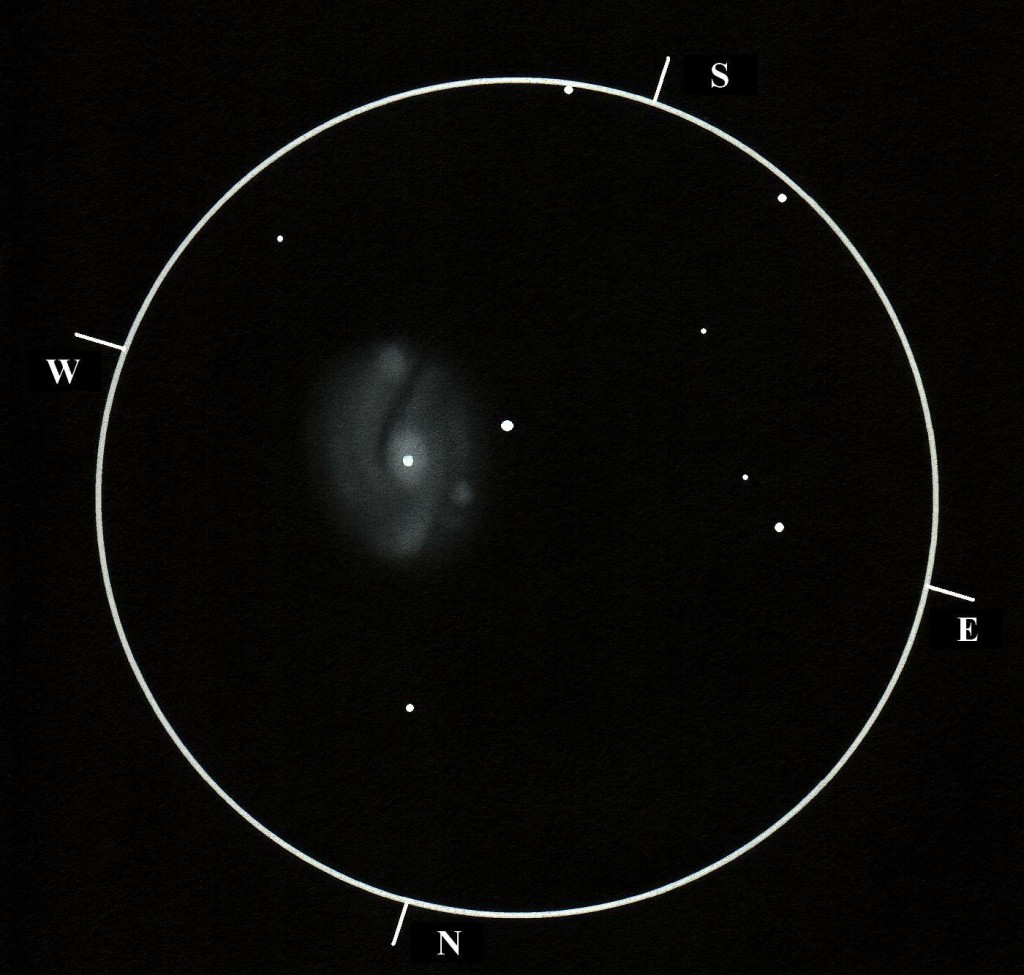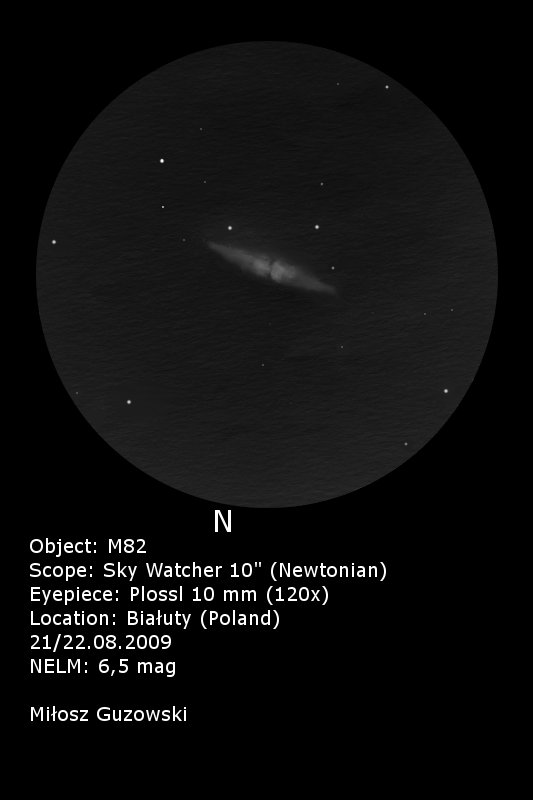
Object: Messier 77 (Seyfert galaxy, Cetus)
Date: 28. 11. 2011.
UT.: 21h01m-21h29m
Equipment: 305/1525 Dobsonian telescope
Mag.: 218x
FOV: 12’
S = 8 / 10 T = 5 / 5
Observer: János Gábor Kernya
Location: Sükösd, Hungary

Object: Messier 77 (Seyfert galaxy, Cetus)
Date: 28. 11. 2011.
UT.: 21h01m-21h29m
Equipment: 305/1525 Dobsonian telescope
Mag.: 218x
FOV: 12’
S = 8 / 10 T = 5 / 5
Observer: János Gábor Kernya
Location: Sükösd, Hungary
M82 is also cataloged as Arp 337, which is a good indication that there’s something unusual about its shape and means that interesting things are going on here. Indeed, it’s an especially vigorous starburst galaxy and has a bi-polar outflow from it core region that’s clearly depicted in many high quality images. This galaxy has a high surface brightness and is well seen in almost (any) size telescope, but the outflow is difficult to see except in silhouette to the brighter galaxy in the background. I was fortunate to have a particularly nice view of this energetic galaxy on February 25, 2011, and what follows is an account of my observation and sketch:
A rare clear February night – on a Friday no less – graced Oregon skies on the 25th so I headed out to my good friend Chuck’s place in the Coast Range mountains west of Portland for a few hours of observing. When I got there I was treated to a pristine, unspoiled and completely overcast sky – what?! It was perfectly clear when I left home for crying out loud! A solitary cloud sprang up right over Chuck’s place late in the day, and even though I saw it forming I was sure it would clear off by dark. Nope.
After waiting a couple of hours the sky started to clear. Feeling optimistic I set up my 28 inch f/4 scope – Chuck’s scope was already patiently waiting under a tarp – and by the time I was ready the sky was 100% clear. Sometimes we get lucky! There was about 4 or 5 inches of snow except on the gravel driveway – fortunately the snow there had melted earlier in the day.
After trying out my new DGM NPB filter on M42 – most excellent – I eventually settled on sketching M82. The conditions were quite nice with surprisingly good transparency and seeing. SQM readings were in the 21.25 to 21.35 range for most of the night. Temperatures fell slowly until a low of 17F at 2am when we called it a night. The Moon was coming up about then and revealed high clouds covering most of the sky, so we had gotten the best part of the night. More good luck.
As soon as I got M82 in the scope it was immediately apparent how good the conditions were because the galaxy was “exploding” with detail. I kept putting on more magnification, and until I got to 816x I kept seeing more internal detail. Most of my sketch was done at 408x and I used higher powers to help confirm some of the smaller and more difficult details. The most pleasing view was at 408x anyway so I really enjoyed the process of making this sketch. Chuck came over and soaked in the view for a while and agreed it was one of the better views he’d had of M82 too.
As always, I saw more than expected simply because I put a good effort into sketching. I don’t recall seeing the small details near the core on either side of the dividing central dark lane before but they sure stood out well tonight. I was also surprised how little the NPB and OIII filters dimmed this galaxy. The filters didn’t reveal other details, M82 just didn’t dim as much as most galaxies do.
The sketch is a result of about 90 minutes active drawing at the eyepiece and then I cleaned it up a bit the next day before inverting it. I used an HB lead pencil and an eraser for the original sketch. I tried a slight variation of my usual technique – I had a piece of stiff cardboard behind the page of my notebook I was drawing in and that gave me a little more control over my sketch. I’m impressed by the result because the raw sketch was much nicer looking in the light of day then normal. It could be a fluke, but I’ll keep at it until I know for sure.
Howard Banich
Hi!
Messier 82 (the Cigar) is the smaller member of the Bode’s Galaxy pair.
About 600 million years ago a Cigar ‘s brother (M81 Galaxy) destroyed
regularity of the galactic-structure, by his strong gravity
Due to their proximity a millions of stars explode as supernovae,
ejecting a huge quantity of matter in the tens of thousands light years
away,
Las night I saw this deformed galaxy with magnification 165 x. The Cigar
like high power and need a good seeing and contrast. So I used 11
“Schmidt – Cassegrain on CGEM mount and the Sky-watcher eyepiece.
This sketch represent more than 40 minutes of staring at the white line
in the dark.
Yours sincerely Robert
Object Name: The Big Cigar
Object Type (Galaxy)
Location (Oborniki, suburbia, Poland)
Date (08-02-2011)
Equipment: 11” Schmidt – Cassegrain on CGEM, SWA SW 17mm
Autor: Ignisdei (Robert Twarogal)
Hi gentlemen,
I propose to day not a showpiece, but a part of it: the dark lane of NGC 5128, Centaurus A, aka The radio galaxy.
Most of the time, when they sketch this galaxy, amateur astronomers resume the dark lane by a black and narrow patch, with one or two details.
But if you can observe it through a big scope, under good skies, and at high power, you will discover a world in itself.
A river with a long and narrow island in the middle, several regions where the depth is strong, and consequently the color of the water in these parts totally dark, but other places with shallow water and the bottom visible in more or less grey color.
There are also some isolated settlements with small lights, and even a village with a hazy spot of non resolved lights on the north shore. A strange thing with this river is its two rivermouths, one at each end!
Of course, this is a rather poetic description, where stars are the lights of settlements, the opacity the consequence of the depth of the water, and so and.
But, really, it’s worth it: you might believe it if you stay a long time at the eyepiece, as I did with a 20” Obsession, at Tivoli Lodge, Namibia.
Have a good dream…
Bertrand Laville, from Marseille / France
www.deepsky-drawings.com

M81, NGC 3034, the “Cigar Galaxy”
Sketch and details by Miłosz Guzowski
Hi,
today I send you sketch of M82 – “broken cigar galaxy”.
Object name: M82
Object type: Galaxy
Location: Białuty (Poland)
Date: 21/22.08.2009
Scope: 10″ newtonian + ploosl 10mm (mag. 120x)
Medium : Graphite/blending stump on white paper + GIMP processing
M106, A Seyfert Galaxy in Canes Venatici
Sketch and Details by Frank McCabe
At a distance of 25 million light years away, M-106 is a bright spiral galaxy with about the same tilt angle as the Andromeda galaxy. This galaxy measures about 30,000 light years across and glows at a magnitude of 8.4. Like M-77 in Cetus this galaxy is a type II Seyfert galaxy. Pierre Méchain found it in July of 1781.
Nearby there is a 12th magnitude edge-on spiral galaxy (NGC 4217) among a group of bright foreground stars. In years past using a 10″ scope, I was able to spot this galaxy before the urban sprawl erased it from my sky.
Sketching:
M 106 (NGC 4258)
Date and Time: 5-18-2009, 4:50-5:25 UT
Scope: 10” f/5.7 Dobsonian. 24 mm eyepiece 60x
8”x12” white sketching paper, 2H, HB, 4H graphite pencils,
blending stump, scanned and inverted
Seeing: Pickering 8/10
Transparency: Average 4/5
Faintest stars visible overhead 4.3
Temperature: 10°C (50°F)
Galaxy magnitude: 8.4
Distance: 25 mly
Location: R.A. 12h 19m
Dec. +47° 18′
Frank McCabe
NGC 5128, The Centaurus A Galaxy
Sketch and Details by Serge Vieillard, some translation by Frank McCabe
During his March 2009 vacation to the African country of Namibia, Serge Vieillard made this stunning drawing of the lenticular, radio galaxy NGC 5128. Using his 405mm (16 inch) home fabricated scope under the dark Namibian night time sky; he captured this view with an 8mm Ethos eyepiece. Serge writes, “… I discover the famous galaxy Centaurus-A under an aspect that I again had never noticed. The absorption band is nicely rippling and is crammed with very fine details. The view allows one also to make out obvious and tenuous zones well beyond the center of the galaxy”…
NGC 7496
By Eiji Kato
NGC 7496 is an 11th magnitude Seyfert Galaxy in Grus that displays a barred spiral structure. It is a member of the IC 1459 Grus Group and weighs in at about 80 Billion Solar Masses. This galaxy was discovered by Sir John Herschel in 1834 at the Cape of Good Hope with an 18-inch f/13 speculum telescope.
Sources:
The Deepsky Observer’s Companion Website
Gas dynamics in barred spiral galaxies. II – NGC 7496 and 289
NGCIC.org
Here is my sketch of Messier 77 (Seyfert Galaxy). It was done on January 19, 2007, with a 12″ Lightbridge. The seeing and transparency were both average. The medium I used was Graphite pencil.
Sal Grasso
Messier 77 is a beautiful face on spiral that lies is the midst of a small group of galaxies in the southern constellation of Cetus. It has the distinction of being one of the most distant of Messier’s famous non comet inventory at about 60 million light years away. This sprawling city of stars is fully 100,000 light years wide and appears to harbor a supermassive blackhole that is currently energizing an accretion disc of infalling dust and gas. Studies with the Chandra Observatory show a beam of X-Ray radiation that is aligned along an axis passing through the galaxy’s core. The presumed engine is the dynamo action of the accretion disc; hot plasmas race around the hole at close to the speed of light, creating magnetic fields that confine and eject matter along the rotation axes of the monsterous gravitational maw.